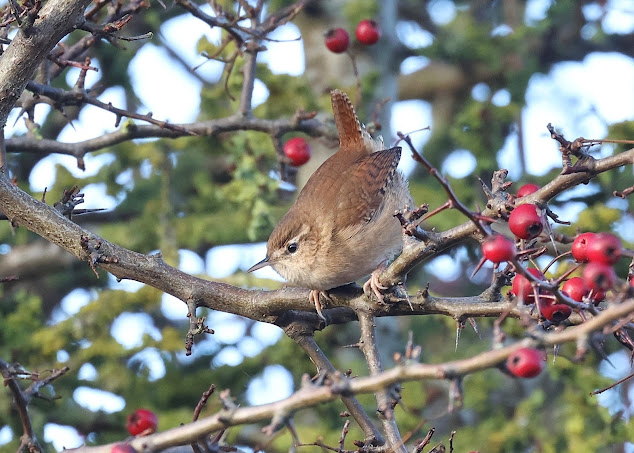November 30th. Cold and frosty with a light north-easterly breeze, but very pleasant again this morning apart from a brief shower of hailstones. Visibility out to sea was excellent. Indeed, flocks of thousands of Pink-footed Geese could be seen leaving their roost on the Norfolk coast! Sea-watching was fairly quiet again with the exception of 5 Great Northern Divers that flew out of the Wash separately during an hour. Two flew north and three veered out north-east. Later in the morning, a group of 3 Great Northern Divers then flew north together! On the beach, 300 Sanderling were feeding and 72 Turnstones were busy turning over the wrack brought up by recent high tides A Bullfinch was a new arrival around the Plantation.
November 29th. A cold and frosty morning but bright and very pleasant. The foreshore was very busy with Gulls and Waders. 420 Sanderling, 62 Turnstone and 80 Redshank were feeding, undisturbed along the shoreline and a Goosander was in Greenshank's Creek. Other birds around were a Water Pipit, a Swallow, a male Hen Harrier and 6 Marsh Harrier, two of which flew south.
November 28th. Calm and dry conditions today and not as cold as expected. The day started with a White-fronted Goose located with roosting Pinkfeet on Tennyson's Sands. The morning sea-watch was fairly quiet except for a Great Northern Diver that flew north and 3 Long-tailed Duck. A few Skylarks, Pipits and Finches were moving south including 3 Brambling and at least 5 Goldcrests and 2 Chiffchaff remain on the Reserve as did the late Swallow.
Honey Fungus, 28th November 2023. Photo - Paul Neale
November 27th. Rain for most of the day limited activity but Blackbirds were very apparent over the west side, with 68 counted in a sample area. The late Swallow was hawking Roadside Pond and 3 Stonechat were around.
November 26th. A cold, frosty and calm morning. Near still conditions were ideal for listening for passing Siskins, Skylarks and Rock Pipits. Offshore a Little Auk flew south and a Long-tailed Duck arrived from the north and settled on the sea close in. A raft of 1600 Common Scoter were at the mouth of the Wash with another raft of 450 Common Scoter off the north end of the Reserve with 4 Long-tailed Duck, 2 Velvet Scoter and 7 Goldeneye.
November 25th. Again, sea-watching was quiet despite a slight northern element to the wind although Eider numbers showed another increase and a Great Northern Diver went north. The highlight of the morning was the arrival of 3 Bewick's Swans from the east, over the sea, then departing to the south-west. Also around were Snow Bunting, Swallow, Short-eared Owl, 5 Marsh Harrier and a Peregrine.
November 24th. A colder day with a north-westerly wind. the wind was not sufficient to create much interest at sea save for a group of 16 Little Gulls moving south, but conditions led to a much increased afternoon tide and a roost of over 15,000 waders.
November 23rd. A brilliant sunrise followed by a bright morning with a westerly breeze. Sightings from the early morning period were fairly routine at sea with a scattering of Common Scoter, Eider, Red-throated Diver and Red-breasted Merganser and a light southerly passage over the West Dunes involving Siskins, Skylarks, Meadow Pipits, Rock Pipits and Chaffinch with 2 Brambling. Elsewhere, the late Swallow was still present and a Hen Harrier was hunting the Old Saltmarsh. At dusk, 8 Marsh Harriers and 3 Hen Harriers came in to roost.
Ringing Control: Starling, ringed West Terschelling, Netherlands 5 June 2023, controlled GPBO 6 July 2023.
November 22nd. A return to south-westerly winds, with a bright start and good visibility. The morning flight of Common Scoter involved over 1000 moving into the Wash with a single Long-tailed Duck. Eider and Red-throated Diver numbers are also increasing and a Slavonian Grebe was on the sea before flying south. 2 Snow Buntings were mobile and a good spread of waders were feeding along the beach again. Brent Goose numbers increased to 580. Also around were 2 Chiffchaff, 3 Blackcap and the regular Swallow.
November 21st. A switch of wind direction giving a hint of north, although still quite mild but with rain and poor visibility initially. Sea-watching through the morning into the early afternoon recorded flocks of Kittiwakes moving south and totaling 213, a Great Northern Diver and 19 Red-throated Diver also south, with a Commic Tern, a Manx Shearwater and 31 Little Gull north. Offshore, 2 Long-tailed Duck were with 450 Common Scoter and a Shag was with the Cormorants. A Grey Heron and small parties of Starlings were arriving off the sea.




































%20Paul%20Neale.jpg)

